 |
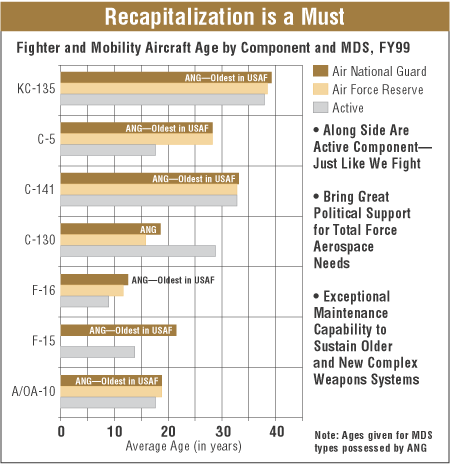
For the world’s most effective,
engaged, and employed reserve component, our Air National Guard capability
in the future hinges on effective weapon system modernization and
recapitalization – along side our Active Component. We need to ensure that
our people are armed with the best and safest equipment our active
component operates. Of the seven major weapon systems the Air Force
operates, the Air National Guard has, on average, the oldest systems in
every one – except the C-130. Our readiness continues to be strained due
in large part to aging aircraft, lack of spare parts, and increasing
workloads associated with both.
Our Air
National Guard modernization efforts and roadmaps continue to push the
envelope for all airframes. We are still focused on our Combat Quadrangle
and AEF support with priorities given to precision strike, information
dominance and battlespace awareness through Data Link/combat
Identification, 24-hour operations and enhanced survivability. Our “medium
look”— extended to 2010 — focuses on structural integrity and engines and
keeping our airframes lethal. Our “long look”— out to 2015 — projects the
future missions and their impact on an expected decreasing force structure
with a focus on seamless forces and capabilities across the Total Force
and our Air National Guard preparations for this future.
(Back
to top)
 |
F-16C/J Fighting Falcon—OPERATION
NOBLE EAGLE (AFIE) - An F-16C/J Fighting Falcon from the New Jersey
Air National Guard’s 177th Fighter Wing, flies a combat air patrol
in the Northeastern United States in support of Operation Noble
Eagle.
Master Sgt. Don Taggart |
F-16 FIGHTING FALCON
To stay current and relevant in our Combat Quadrangle,
we continue to press in all four areas — especially our Targeting Pods. We
have a plan to have the entire Air National Guard F-16 community armed
with this precision strike capability by Fiscal Year 2006. After 11
September, as we saw the benefit of these Pods for Visual Identification,
we recognized a critical need to push these schedules up significantly.
Support and funding have enabled us to make some major in-roads this year
and set the foundation for continued improvements.
Our F-16, pre-block 40 fleet, becomes more interoperable
and lethal everyday, now possessing full front line combat capability.
However, we still need to tell that capability story better. We
continually find others who don’t understand our enhanced capabilities.
They assume our F-16 pre-block 40’s are only “near Precision Guided
Munitions (PGM)” capable and as a result, they inaccurately place
limitations on their use. These assumptions are quite simply dead
wrong.
Continued support is vital to
our efforts to continue this critical program and remain a fully relevant
Total Force partner. Our Block 25/30/32 jets are capable of employing
Precision Guided Munitions by means of a self-designated laser-targeting
pod. Our last group of pods started delivery in March 2001 continuing
through the February 2002 time frame. Combined with prior purchases, this
will give us a total of 64 pods in our fleet. We still need 96 more pods
to fill our one-for-one requirement.
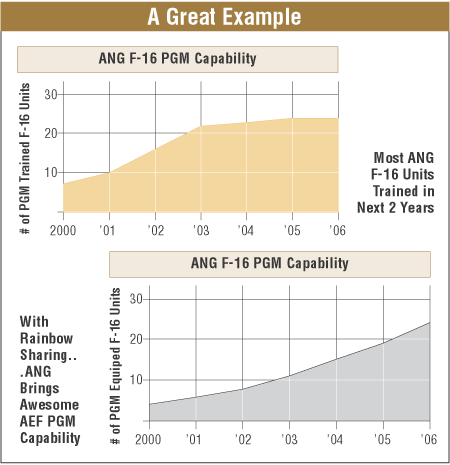
We are hopeful this year’s
funding will allow us to put a significant dent in this outstanding
requirement. Until then, with “rainbow” sharing of existing pods, the Air
Guard will have nearly all our pilots, weapons loaders, and maintenance
crews fully trained to deliver— full, not near– PGM capability. In other
words, Air National Guard Block 25/30/32 F-16’s will have the same
capability as the Air Force F-16 workhorse — the Block
40/42.
When we add a new capability—
the Theater Airborne Reconnaissance System or TARS these F-16’s will
become increasingly viable as both a weapons delivery system as well as an
information exploitation platform.
TARS
will return the manned tactical reconnaissance mission to the Air Force.
In keeping with the modern battlefield’s need for a responsive kill-chain,
TARS improves the Air Force’s ability to find, identify, and engage
mobile/relocatable targets.
Our current
capability includes two electro-optical sensors for day, under the weather
reconnaissance. We are working closely with our industry partners on an
improvement package to add synthetic aperture radar (SAR), a data link,
and the high bandwidth necessary to make this system an all-weather, day
or night sensor. We demonstrated the ability to gather and relay critical
information through the data link to the Air Operations Center (AOC). The
result will be bombs on target within single digit
minutes.
All of our Block 25/30/32 jets
are wired for the Global Positioning System (GPS) giving us precise
navigation and target acquisition capability. At the same time our Night
Vision Imaging System (NVIS) is completely installed on our F-16’s giving
us 24-hour combat capability. Combined with installation of the
Situational Awareness Data Link (SADL) we have significantly improved our
F-16 Fleet. To meet our Combat identification requirements we need to give
our Block 25/30/32 aircraft an ability to identify both allies and
adversaries. A procurement of an Advanced Identification Friend or Foe
system will go a long way to enhancing the F-16’s combat identification
capability. We now need full support for “Falcon Star” - a structure
modification program that significantly extends the service life of this
airplane and critical now more than ever since the events of September
11th.
With a focus on Precision Guided
Munitions capability, combined with Falcon Star engine and structure
modifications and TARS, the Air National Guard F-16 block 25/30/32
community will provide the bridge to the next generation of
power-projection precision combat systems.
(Back
to top)
KC-135
STRATOTANKERS
But our fighters don’t get to
the fight or get home safely without the efforts of our stalwart Tanker
fleet. Increasingly, our Air Guard modernization focus has shifted to
necessary improvements in our KC-135 fleet. With congressional
authorization to lease up to 100 wide body tankers in the Fiscal Year 2002
budget, we now have the additional possibility of replacing our aging
E-models with either flow down KC-135Rs from the active duty fleet or new
tankers for selected units.
 |
KC-135 and F-16CJ—Lt. Col James
Horton, 79th Fighter Squadron commander, refuels from a KC-135 of
the Nebraska ANG in an F-16CJ over western Colorado during a large
force employment exercise in conjunction with the Inaugural Tiger
Meet of the Americas held in Colorado.
USAF photo by SSgt. Greg
L. Davis |
Bottom line - we need to continue
the modernization of our tanker fleet. Replacing the E-models with either
active duty R-models or KC-X wide body tankers is the best solution.
However, if the KC-X version does not work out, then it is critical we
upgrade from the aging and operationally unsuitable E-models as soon as
possible. We have a consolidated plan in place that includes the purchase
of 100 R-conversion kits at a rate of 16 per year. This would fix two full
squadrons a year over the next six years at a cost of $352 million
per.
With the Pacer Crag upgrade
complete this summer and the Global Air Traffic Management (GATM) kits buy
beginning, we are well on our way to serious improvements in our Air Guard
tanker assets.
With our anticipated
addition of Situation Awareness Data Link (SADL), the Air National Guard
once again leads the way for issues that directly affect future
expeditionary operations. With nearly half the entire air-refueling
mission, the Air National Guard must not let tanker modernization issues
be ignored.
(Back
to top)
C-130 HERCULES
Another concern that has surfaced in light of changing
strategy requirements is whether or not we truly have 100 too many C-130’s
in service. Homeland Security and increasing Quick Reaction Forces
requirements may alter force structure with a 3-front war (AEF, Noble
Eagle, and Enduring Freedom).
With increasing reliance on our
Tactical Airlift workhorse, the C-130, we are still pushing to fully fund
the cockpit armor requirements necessary to operate in hostile conditions.
This armor upgrade, mandated by United States Central Command, will make
significant improvements in the survivability of our fleet while
supporting AEF taskings. We need defensive countermeasures systems and
battlespace situational awareness capabilities that allow us to operate in
hostile conditions and to counter the prolific infrared
threats.
We continue our work to bring
the full complement of C-130J aircraft to Air National Guard units in
Maryland, Pennsylvania, Rhode Island, and California.
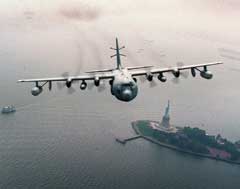 |
EC-130—Commando Solo makes a pass
over the Statue of Liberty. Commando Solo is an EC-130 aircraft used
for psychological operations and flown by the 193rd Special
Operations Wing, Pennsylvania Air National Guard.
U.S. Air Force
photo |
In addition, our Air National Guard
unit in Harrisburg, Pennsylvania is converting from their EC-130Es to the
EC-130Js cross-decking the special mission equipment that makes this
one-of-a-kind psychological warfare mission possible. Even as this
modernization program continues, Air National Guard Commando Solo aircraft
and crews are conducting operations over Afghanistan. By converting to the
EC-130Js, we will be progressing in this “revolutionary” program working
with all stakeholders to iron out the bugs that come with any new weapon
systems. We continue to complete our C-130J conversions as aircraft are
fielded. This program will modify the C-130 fleet through 2013 making it
viable well into this century.
Our
biggest Total Force issue remains the C-130 Avionics Modernization Program
(AMP) development. With the award of the AMP contract to Boeing, the Air
National Guard is fully supporting the System Program Office. The Air
National Guard is providing the first aircraft, a C-130H2, to the Air
Force Flight Test Center and Boeing for AMP
flight-testing.
The Mobility
Requirement Study, Homeland Security transportation needs, and the Army
Transformation all point to increasing reliance on this highly reliable
mobility asset.
(Back
to top)
C-5 GALAXY
The Air National Guard will take all the C-5B’s
Galaxies that the Active Component Air Force wants to give us, and we’ll
get them and keep them in top shape.
The C-5 Avionics Modernization Program (AMP) is the first
of a two-phased comprehensive modernization for the C-5. This program
redesigns the architecture of the avionics system, installs All-Weather
Flight Control System (AWFCS), Traffic Alert and Collision Avoidance
System (TCAS), Terrain Awareness and Warning System (TAWS) and makes the
C-5 Global Air Traffic Management (GATM) compliant. The AWFCS replaces low
reliability Line Replaceable Units (LRUs) in the automatic flight control
system and replaces aging mechanical instruments in the engine and flight
systems. A GATM capability, which encompasses communications, navigation,
and surveillance (CNS) requirements, will be concurrently incorporated
into the aircraft to maintain worldwide airspace access well into the 21st
Century.
The Reliability Enhancement
and Re-engining Program is the second of the two-phased modernization of
the C-5 that improves reliability, maintainability and availability. This
effort centers on replacing TF39 engines with more reliable, commercial
off the shelf turbofan engine. This program also upgrades numerous other
systems including: flight controls, electronics, hydraulics, landing gear,
fuel system, airframe, fire suppression system, and pressurization/air
conditioning system.
It’s critical to
the national lift requirements that the C-5 systems are modernized under
the Reliability Enhancement and Re-engining Program and used to fill the
near 55 million ton mile per day lift requirements for a moderate-risk
capability to support the National Military Strategy.
(Back
to top)
C-17 TRANSPORT
As we contemplate an increase of C-5 Galaxies, the Air
National Guard also needs more C-17’s. With the current focus on strategic
airlift shortfalls, many hope for an increase in C-17 fleet-wide numbers.
As a result, we support additional C-17’s for both the Air Force and the
Air National Guard to adequately meet the full range of strategic lift
requirements.
The Air National Guard is
striving to move the C-17 conversion forward at Jackson, Mississippi -
replacing aging and retiring C-141s. We are laying the groundwork for the
necessary infrastructure and support requirements, however we harbor
serious concerns regarding the associated funding. We continue to work for
the bed down in Fiscal Year 04
Not only
do we need to continue the conversion efforts in Jackson, the Air National
Guard advocates far more C-17’s in the Air Guard with Active Associate
attached units to facilitate the crew ratio requirements to keep this
airplane fully utilized.
Congress and
the United States Air Force are reviewing the Alaska and Hawaii C-17
stationing options, as well as studying other “hubs” among the mid-western
states.
(Back
to top)
F-15 EAGLE/F-22
RAPTOR
The U.S. House of Representatives
defense appropriations subcommittee on May 11 endorsed spending almost $4
billion in 2001 for continued development of the F-22 Raptor. The $3.96
billion allotment would pay for ten initial production planes and advance
funding on 16 more of the next-generation air superiority
fighters.
 |
Two F-15 Eagles from the
Massachusetts Air National Guard’s 102nd Fighter Wing fly a combat
air patrol mission over New York City in support of Operation Noble
Eagle. The F-22 Raptor, insert photo, is the air-superiority fighter
slated to replace the F-15.
U.S. Air Force photo by Lt. Col. Bill
Ramsay |
The F-22 Raptor, developed at
Aeronautical Systems Center, Wright-Patterson Air Force Base, Ohio, is the
replacement for the F-15 Eagle air-superiority fighter and will become
operational early in this century. It combines stealth design with the
supersonic, highly maneuverable, dual-engine, and long-range requirements
of an air-to-air fighter. It also will have an inherent air-to-ground
capability, if needed. The F-22’s integrated avionics gives it first-look,
first-shot, first-kill capability that will guarantee U.S. air dominance
for the next three decades.
Even once
the F-22 becomes operational, F-15s will remain a critical warfighter. Air
National Guard F-15s led the Air Superiority role in AEF 9 in Southwest
Asia while continuing their air sovereignty alert requirements at home.
This valuable weapon system struggles to remain viable versus ever more
capable threats. The 26.4 million dollars added for the Bolt-On-Launcher
(BOL) for advanced infrared countermeasures and the 17.5 million dollars
added to complete installation of the Fighter Data Link (FDL) ensures the
National Guard F-15s are able to face the threats being faced during their
AEF rotations.
Future critical F-15
upgrades include the Joint Helmet Mounted Cueing System, Advanced
Identification Friend or Foe upgrade to enhance combat identification,
Airborne Video Recording System to capture crucial Fighter Data Link
information for quality mission debriefing employment training, engine
upgrade for sustainability issues, and Tactical Electronic Warfare System
upgrade to survive current and future emerging
threats.
We are still concerned with
the long-term reliability and sustainability issues associated with this
aging aircraft. In order to maintain our ability to provide a reliable
combat ready force, the ANG F-15’s will need to upgrade its current
engines. With 40 million dollars in engine funding already secured, we
must stay engaged to continue this critical modernization strategy. With
the changing demands of today, we need to study the future of this
community and consider the implications of Air Force F-22 Raptor
purchases.
Our current plan is to
realize the benefits of Air Force F-15 flow-downs. The current Air Force
F-22 program anticipates the Air National Guard in only an associate role.
We feel that in order to meet the challenges of tomorrow, the Total Force
F-22 program must expand in the future to include an Air National Guard
presence in a unit equipped role.
(Back
to top)
HH-60G PAVE HAWK
HELICOPTER
The primary mission of the
HH-60G Pave Hawk helicopter is to conduct day or night operations into
hostile environments to recover downed aircrew or other isolated personnel
during war. Because of its versatility, the HH-60G is also tasked to
perform military operations other than war. These tasks include civil
search and rescue, emergency aeromedical evacuation (MEDEVAC), disaster
relief, international aid, counterdrug activities and National Aeronautics
and Space Administration space shuttle support.
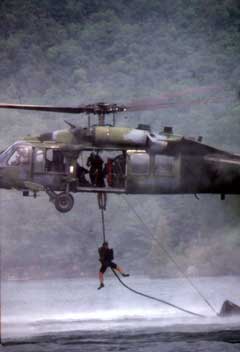 |
Pararescuemen
from the 102nd Rescue Squadron, New York Air Guard, fastrope from an
HH-60G helicopter into Lake George.
U.S. Air Force photo by Tech.
Sgt. Ken Wright |
The Pave Hawk is a highly modified
version of the Army Black Hawk helicopter which features an upgraded
communications and navigation suite that includes an integrated inertial
navigation/global positioning/Doppler navigation systems, satellite
communications, secure voice, and Have Quick
communications.
The Air National Guard
has 18 HH-60Gs at units in New York, California and Alaska. All aircraft
now have 701c engines, Forward Looking Infrared Radar (FLIR), and
operating 7.62mm self-protection weapons.
The self-protection system has AAR-47 Missile Warning
System and ALE-47 Counter Measures Dispenser System to protect against
Infrared Surface to Air Missiles. Three Air National Guard HH-60s have
been modified. Five more are scheduled in Fiscal Year 2002. The Air
National Guard is at the forefront of fielding Situation Awareness Data
Link on the HH-60. The Situation Awareness Data Line will integrate the
HH-60 into the Combat Search and Rescue Task Force with F-16s and
A/OA-10s. The program is scheduled to begin in Fiscal Year 2002 and will
outfit all ANG. Other requirements are not funded but are validated.
Funding can be executed immediately for near-term capability.
(Back
to top)
A-10 THUNDERBOLT II
The A/OA-10 Thunderbolt II is the first Air Force
aircraft specially designed for close air support of ground forces. They
are simple, effective and survivable twin-engine jet aircraft that can be
used against all ground targets, including tanks and other armored
vehicles.
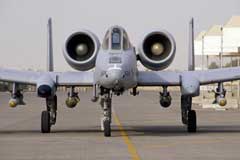 |
Air National
Guard A-10 Thunderbolt IIs are deployed in Kuwait in support of
Operation Southern Watch.
Master Sergeant 1st Class Tom
Meneguin |
Basically the A-10 has a three-part
requirements “triad.” First, the focus over the last year for our A-10’s
has been to insure precision engagement capability that includes SADL,
Targeting Pod integration, DC power, digital stores management system, and
a 1760 bus. These modifications will modernize the A-10 cockpit and allow
the aircraft to drop precision munitions. Secondly, the “Hog-Up” is a
funded Air Force Material Command initiative that is fully funded and will
primarily replace wing spars. Lastly, current engines lack sufficient
thrust in the medium altitude regime. With new engines the A-10 will be
able to perform all missions with better survivability. The Air National
Guard will complete writing the operational requirements for the new
engine in 2002. An engine competition will occur after those requirements
are approved.
With all three programs,
the A-10 will be able to increase its service life from the projected 2014
to 2028. However, in some circles, the A-10 is still perceived as a “cash
cow” and reprogramming could jeopardize our initiatives to upgrade these
systems. We are looking at more commercial off-the-shelf (COTS) engine
solutions to save money and still improve the capabilities of this
first-called, most-used “hog.” Eventually the Joint Strike Fighter will
replace the A-10.
(Back
to top)
LOW ALTITUDE NAVIGATION AND
TARGETING INFRARED FOR NIGHT (LANTIRN)
The
ingenuity of Air National Guard transformation initiatives has made
positive, mission impacting strides for our total force. Recently, our
unit in Tulsa, Oklahoma conceptualized, assisted in the development and
testing, and fielded a down-sized Low Altitude Navigation and Targeting
Infrared for Night (LANTIRN) pod test station.
The previous legacy test station used in the Air Force,
LANTIRN Mobile Support Shelter (LMSS), is currently considered too large
to be moved effectively to support contingencies due to the airlift it
consumes. The new downsized test station fielded by the Air National Guard
gives the Air Force an optimum deployment LANTIRN support capability that
is otherwise not available.
(Back
to top)
SUPPORTING CONGRESS
The 201st Airlift Squadron, District of Columbia Air
National Guard provides worldwide air transportation for Congressional
Members/Delegations (CODEL), the Executive Branch, Department of Defense
officials, high-ranking U.S. and foreign dignitaries and, Headquarters
U.S. Air Force inspection team travel.
The 201st currently uses three C-22B aircraft to meet team
travel and CODEL missions. The C-22Bs are 1964 model Boeing 727-100
aircraft, which are scheduled for retirement due to age and upgrade costs.
The first aircraft has already retired and the remaining two are scheduled
for retirement in November of 2002 and 2003. Congress recognized the need
for replacement aircraft and provided funding in the Fiscal Year 2001
budget to purchase the first C-40. The identification of “C-40” is the
military designation for Boeing 737s. In the Fiscal Year 2002 budget
Congress authorized the lease of four additional 737s. Negotiations are in
process with the Air Force to determine the disposition of those aircraft.
The unit has an existing requirement for four medium-capacity aircraft,
and depending on the disposition of the leased aircraft, funding may be
required to purchase additional aircraft to meet the unit’s
requirement.
(Back
to top)
SUMMARY
This is where our Air National Guard Force is
headed. This is where we need to go with them. The readiness levels of the
Air National Guard depend on modern equipment availability. Adequate
funding levels for Air Guard equipment are becoming increasingly
critical.
We are being called on to
perform a greater share of day-to-day missions, as well as to relieve the
high operational tempo for active duty forces. We can no longer wait until
new weapon systems are totally fielded in the active component first.
Compatible equipment is essential to reduced logistics costs and to enable
Active, Guard and Reserve units to train and fight
together.
Our Air Guard warriors — the
men and women who patrol the skies of Northern and Southern Iraq as part
of the Aerospace Expeditionary Forces or AEFs, and flying critical Combat
Air Patrols (CAP) sorties over our American cities deserve
comparable
equipment for committed and sustained contributions.
|












